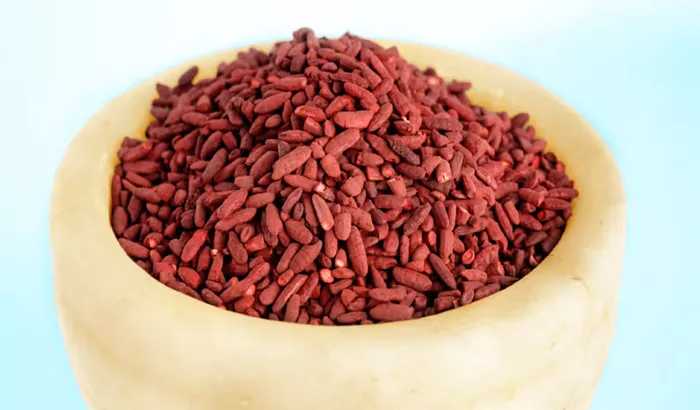Red yeast rice is getting a lot of attention as a “natural” way to lower cholesterol. But before you ditch your prescription or grab a supplement off the shelf, here’s what the science really says — in plain English.
1. What Is Red Yeast Rice?
Red yeast rice is made by fermenting rice with a type of yeast called Monascus purpureus. The result? A deep red-colored substance that’s sold in capsules, powders, and tablets as a dietary supplement.
What makes it interesting to doctors and researchers is that it contains a compound called monacolin K — which is chemically identical to lovastatin, a prescription medication used to lower cholesterol. But there’s a catch: not all red yeast rice supplements contain effective amounts of monacolin K, and that inconsistency matters.
2. Can Red Yeast Rice Lower Your Cholesterol?
The short answer: Yes, it can — but only sometimes.
When red yeast rice has enough monacolin K, studies show it can reduce LDL cholesterol (the “bad” cholesterol) by 15% to 34%, especially in people with mildly or moderately elevated levels. That’s a similar drop to what you’d get from low-dose statin drugs.
But here’s the twist: many supplements have too little monacolin K to work. And since supplement makers aren’t required to meet consistent quality standards in the U.S., there’s a big question mark around what you’re actually getting in each pill.
3. Is It Better Than Prescription Medications?
Not necessarily. Prescription statins are FDA-approved, meaning they go through strict testing and quality control. You know exactly what you’re getting — and in what dose.
Red yeast rice supplements aren’t regulated the same way. Studies have found that some brands don’t contain any detectable monacolin K at all. Others contain varying (and sometimes illegal) amounts of added lovastatin, which raises serious safety concerns.
If you’re already taking statins, adding red yeast rice could lower your cholesterol too much, or increase your risk of side effects like muscle pain or liver damage.
4. Does Red Yeast Rice Reduce Heart Disease Risk?
Possibly. Because high LDL cholesterol increases the risk of heart disease, lowering it with red yeast rice might help — especially if you’re not taking other cholesterol medications.
Some studies also show that red yeast rice may improve other heart-related markers, like lowering total cholesterol, ApoB (a protein tied to LDL), and blood pressure. But these results aren’t consistent, and experts agree: more research is needed to confirm its full heart-protective benefits.
5. What About Diet and Exercise?
Don’t skip the basics. Eating a heart-healthy diet, staying active, managing stress, and getting enough sleep are still the first-line tools for keeping cholesterol in check.
In fact, one small study showed that combining lifestyle changes with red yeast rice worked better than lifestyle changes alone.
The Mediterranean diet, which includes lots of fruits, veggies, whole grains, fish, and olive oil, has proven cholesterol-lowering power — and it doesn’t come with side effects.
6. Is Red Yeast Rice Safe?
It depends. While many people take it without problems, side effects do happen — and in some cases, they can be serious.
Common mild side effects may include:
- Nausea
- Gas or bloating
- Constipation or diarrhea
- Headache
- Skin rash or eczema
But there are more serious concerns too:
Kidney injury has been reported, often tied to contamination with a substance called citrinin, a toxic byproduct of fermentation.
A review of 37 red yeast rice products found all contained citrinin — even those labeled “citrinin-free.”
Only 4 products had citrinin levels low enough to meet European safety standards.
Also worrying: In a test of 28 supplements, two had no monacolin K at all, and many had amounts far below what’s needed to lower cholesterol. The ideal range appears to be 3–10 mg of monacolin K per serving, but only a handful of products meet that.
7. Who Should Avoid Red Yeast Rice?
Not everyone should try this supplement. Certain groups should steer clear:
- Pregnant or breastfeeding women — safety hasn’t been studied
- People with kidney disease — due to the citrinin risk
- People already on statins — may increase the risk of side effects
Anyone with liver problems or on multiple medications — potential for drug interactions
Talk to your healthcare provider before taking red yeast rice, especially if you fall into one of these categories.
8. How to Choose a Safe Supplement
If you decide to try red yeast rice, here’s how to reduce your risk:
Look for third-party testing: Choose products verified by NSF International, USP (U.S. Pharmacopeia), or ConsumerLab.com.
Avoid unknown brands or very cheap options: They may cut corners or be poorly made.
Check for full ingredient lists: Watch for added lovastatin or other undeclared ingredients.
And always talk to your doctor first. Just because it’s “natural” doesn’t mean it’s safe or effective for you.
Key Takeaways
Red yeast rice may lower LDL cholesterol in people with mild to moderately high levels — if the supplement contains enough of the active compound monacolin K.
Its effects are similar to low-dose statins, but without the consistency or regulation.
Safety varies widely, with risks including kidney damage and contamination from citrinin.
A healthy lifestyle remains the foundation of cholesterol management. Use supplements as a complement, not a replacement.
Read more:
- Algae Oil vs. Fish Oil: Which Is Healthier for Your Body and Brain?
- Can a Vegan Diet Help with Hot Flashes? A Surprising New Study Says Yes
- Young Adults See Sharp Rise in Appendix Cancer: What You Need to Know


